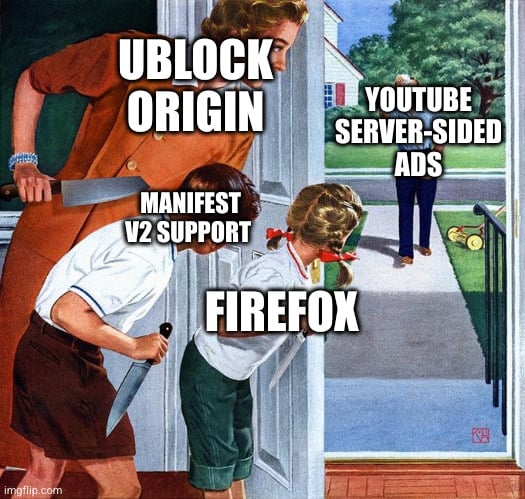this post was submitted on 10 Oct 2024
976 points (97.8% liked)
memes
10334 readers
2369 users here now
Community rules
1. Be civil
No trolling, bigotry or other insulting / annoying behaviour
2. No politics
This is non-politics community. For political memes please go to !politicalmemes@lemmy.world
3. No recent reposts
Check for reposts when posting a meme, you can only repost after 1 month
4. No bots
No bots without the express approval of the mods or the admins
5. No Spam/Ads
No advertisements or spam. This is an instance rule and the only way to live.
Sister communities
- !tenforward@lemmy.world : Star Trek memes, chat and shitposts
- !lemmyshitpost@lemmy.world : Lemmy Shitposts, anything and everything goes.
- !linuxmemes@lemmy.world : Linux themed memes
- !comicstrips@lemmy.world : for those who love comic stories.
founded 1 year ago
MODERATORS
you are viewing a single comment's thread
view the rest of the comments
view the rest of the comments

I am not for ads but what is so difficult about adding them to the video stream. This should make adblockers useless since they can't differentiate between the video and the ad. I could just imagine it would be difficult to track the view time of the user and this could make the view useless since they can't prove it to the ad customer. I have no in depth knowledge about hls but as I know it's an index file with urls to small fragments of the streamed file. The index file could be regenerated with inserted ad parts and randomized times to make blocking specific video segments useless.
I worked at a video ad server that offered a stream stitched solution going back to 2013. It comes down to development work/cost that the companies need to take on. Ultimately they would benefit from the cost required, but they wanted to be cheap and do a client side solution instead.
Ah yes that makes a lot of sense. Googles war on adblockers seems really expensive but we don't know the numbers maybe it's still cheaper.
The HLS integration we offered definitely had a premium attached to it as well as an additional cost to the CDN that required the integration to live on. So it's not cheap.
It is weird that Google, with it's infinite pockets, hasn't pushed a stream stitched solution all these years until recently.
YouTube serves probably dozens of formats/bitrates, and has spent years tweaking how it ingests, transcodes, and serves videos. Adding in-stream ads might have been a bigger engineering task in that environment. Depending on the percentage of users/viewers avoiding ads, it might not have been worth the return.
As I know they transcode every uploaded video to their preferred format. They could use the same infrastructure for the ads. But maybe it's really too expensive.
You are correct, which goes into the cost category of doing a stream stitched integration. Also, when I left said ad server in 2016, I think I recall HLS streaming primarily supported by Apple devices. Devices like Roku's (don't quote me on that) didn't support it at the time so a lot of companies looked at where the majority of their streaming was occurring and decided it wasn't worth the hit.